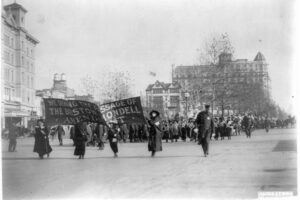110 Years Ago This Week, Women Marched on Washington for Right to Vote
One of the first large-scale civil rights protests in the nation’s capital — to secure voting rights for women — took place 110 years ago this Friday.
The “Great Suffrage Parade” took place on March 3, 1913 — the day before Woodrow Wilson’s inauguration — when the large procession set out down Pennsylvania Avenue, according to Susan Philpott, U.S. Park Service ranger at the Belmont-Paul Women’s Equality National Monument.
Activist Alice Paul was the driving force behind the organization of the protest, which included a parade down the same route Wilson would use.
“Alice Paul was using the publicity around the inauguration, and all the crowds that were going to be in the nation’s capital for that event to highlight that women had been completely excluded from the electoral process,” said Philpott. “As far as we know, this was the first large-scale protest down Pennsylvania Avenue.”
At the head of the line of 20 floats was one displaying a banner that would become known as “The Great Demand,” which read: “We demand an amendment to the Constitution of the United States enfranchising the women of this country.”
Philpott said The Great Demand represented a change in policy in how women were seeking the right to vote: “Alice Paul was declaring that the women’s suffrage movement should refocus its attention away from winning the vote in states, and toward changing the U.S. Constitution.”
The march drew a huge crowd.
“There were about 250,000 people, we think, who lined Pennsylvania Avenue to watch this procession,” said Philpott. “Police were not doing much of a job of controlling the crowds.”
At some point, the marchers found themselves trapped in a sea of hostile men.
“There were angry, and perhaps intoxicated, men in the crowd, who started jeering them and grabbing them,” said Philpott. “The (U.S. Army) cavalry arrived, from over in Arlington, and they were able to clear the crowds, so the march did continue.”
Philpott said the procession “brought new energy to the movement.” While Paul thought it would just be a few years before activists were able to win the amendment, amending the U.S. Constitution turned out to be more difficult.
Six years after the march, on June 4, 1919, Congress passed the 19th Amendment to the U.S. Constitution, granting women the right to vote.
